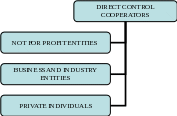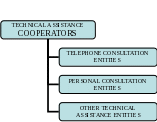Part B
Part B.doc
National Management Information System (Wildlife Service)
OMB: 0579-0335
B. Collections of Information Employing Statistical Methods
Form 25 (WS Customer Satisfaction and Wildlife Damage Survey) contains questions to which statistical methods will be applied. Questions that ask respondents to check one of several responses may be subjected to analysis to determine the percentages.
1. Describe the potential respondent universe and any sampling or other respondent
selection methods to be used.
The potential respondent universe of the collection using Form 25 is the entire Cooperator
cohort of WS defined as cooperators who conducted business with WS in the prior 24 months.
This annually averages 75,349 entities (mean of Fiscal Years 2001, 2002, 2003) comprised of
Federal, State, and Local Government representatives, private business and industry
representatives, and private citizens. These are stratified into: 1) technical assistance, and
2) direct control cooperators, depending on the kind of program they participate in. The data for this respondent universe by strata, estimated sample size, and expected response rate are presented in the table below:
Respondent Groups |
# of Potential Respondents |
Estimated Sample Size |
Expected Response Rate (%) |
Technical Assistance Cooperators |
55,145 |
382 |
65 |
Direct Control Cooperators |
20,204 |
377 |
65 |
T |
7 |
|
|
Total Estimated Sample Size |
759 |
|
|
A |
65 |
||
2. Describe the procedures for the collection of information including:
Statistical methodology for stratification and sample selection: stratification of the
sampling frame is by type of cooperator. For all respondents, eligibility for the sample canvass will be that each be an active Cooperator or have conducted business with WS within the past 24 months. Routine updates of cooperator data as a result of records management procedures or renewal of agreements maintain the respondent universe and the sample.
An attempt is made to conduct a maximum-diversity sample by surveying respondents from 3 categories within the technical assistance cooperator cohort and 3 categories within the direct control cooperator cohort. The following diagrams demonstrate this diversified subdivision:


These 6 subcategories reflect the diversity of communities in the sample.
This scheme should ensure appropriate representation of the respondent universe.
Sample sizes of each of the two primary respondent cohorts are calculated using procedures described below. In determining the sample size, APHIS assumed a margin of error (confidence interval) of 95%.
Sample size for the technical
assistance cooperator cohort was derived using the formula:
![]()
Where S is the standard error of a percentage, p is the percentage found in the sample, and q is 100 – p2 , and n is the size of the sample. Solving for n APHIS assumed p to be 50%.
Sample size for the direct control cooperator cohort was derived using the formula:

and then calculating for a confidence level of 95% as:
n = M / ((((E / 1.96) ^ 2 * (M - 1)) / (p * (100 - p))) + 1) where E is the maximum allowable margin of error (5%).
With values as : n = sample size
M= finite correction factor using the respondent universe as its value
p = percentage found in the sample; assumed at 50%
q = 100 – p
E = maximum allowable margin of error
S = standard error of a small sample size (less than 50,000) calculated as :
![]()
This calculation was facilitated using a sample calculator developed by Creative Research Systems, 411 B St., Suite 2, Petaluma, CA 94952 USA at: http://www.surveysystem.com
Estimation procedure: Data for estimates is derived from responses by sample groups sampled not more than biennially. All respondents are asked identical questions related to resources damaged or threatened, species causing damage, and their opinions about their experience with WS.
Degree of accuracy needed for the purpose described in the justification: C.I. = 5 at 95%.
Confidence Level. There are no unusual problems requiring specialized sampling procedures.
Use of less frequent than annual data collection cycles: No more frequently than every 2 years.
3. Describe methods to maximize response rates and to deal with issues of non-responses:
Surveys using Form 25 will be offered in telephone questionnaire, e-mail, and postal mail formats. Initially, WS attempted to conduct surveys by phone calls or e-mails, with postal formats as a final alternative. For those choosing to use e-mail or postal mail surveys, the initial phone call represents a pre-notification of intent to send a survey. However, some Cooperators who use e-mail systems are contacted by e-mail initially. For those, the first e-mail is a notice that WS is sending them a survey to complete. These pre-notifications are then followed by another e-mail containing the survey and explanations. All attempts to obtain a response, except the telephone queries, are followed by one reminder requesting the information from non-responders. This reminder is accompanied by a replacement copy of the survey. A record of completed surveys and non-responses are kept.
Because e-mail solicitations can be generated only through pre-notification of WS customers, who are already familiar with the Agency, low response rates reported by Sheehan (2001, www.ascusc.org/jcmc/vol6/issue2/sheehan.html) are not expected.
4. Describe any test procedures or methods to be undertaken.
One test for the procedure and collection methods was employed to determine the time burden calculation for Form 25, the survey instrument. WS employees were asked to role-play and complete the survey, tracking time for both the role of the employee, and the role of the respondent. In addition, their suggestions about readability and organization of the survey documents were incorporated into the survey’s design.
5. Provide the name and telephone number of individuals consulted on statistical aspects of the design and the name of the agency unit, contact(s), grantee(s), or other person(s) who actually collect and/or analyze the information for the agency.
The following individuals were consulted on statistical aspects of the design:
Alice Wywialowski – 301/734-4379
John Sinclair – 301/734-8281
Analysis of data is performed by collaborative effort among WS, APHIS – Policy and Program Development, and APHIS – Centers for Epidemiology and Animal Health.
| File Type | application/msword |
| Author | cbsickles |
| Last Modified By | cbsickles |
| File Modified | 2007-10-15 |
| File Created | 2007-10-15 |
© 2025 OMB.report | Privacy Policy
 otal
Respondent Universe
otal
Respondent Universe